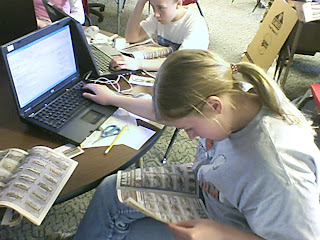Here are some resources for teaching mean or average.
You tube mean lesson:
http://www.youtube.com/watch?v=tgxZfQDf4qY
Online dice .. Have students "roll" a set number of times and calculate the mean:
http://www.random.org/dice/
Online playing cards..Have students "draw" a set number of cards and calculate the mean:
http://www.random.org/playing-cards/ndom.org/playing-cards/
Candy Colors Average Activity:
http://www.education-world.com/a_lesson/03/lp293-02.shtml
The Average Kid lesson plan:
http://www.education-world.com/a_lesson/00-2/lp2057.shtml

You know those free auto magagizines you see around town? How about using them for an averaging activity? I've used them before for place value, and my students absolutely loved it! You could use one of the following problems for a whole class activity, or you could put them on a think-tac-toe board.
- Cut out 3 (or more) vehicles. Find the average.
- Find 3 vehicles that were made in 1990's and calculate the average.
- Find 3 more vehicles that were made in the 2000's and calculate the average. What is the average difference between them? Why reasons can you think of that would explain the difference
- Find the average of all the cars on a page. (Put this in the center of the think-tac-toe board and encourage students who need more challenge to include it in their choices.)
- Find 5 cars that show a monthly payment. Find the average monthly payment of the cars. (This would be easier for students to calculate.)
- Use Mapquest to find the distance to several of the car dealers. Calculate the average distance.
- Find 5 cars that are named after animals. Calculate the average.
- Fnd 5 cars that are alike in some way (leather, AC, CD, same year..etc.) Calculate the average price of the cars.
Here are some other tasks for a choice board:
- Find two vehicles that were made in the same year and are the exact same price.
- name two vehicles that are named after cities in the United States. Tell what state they are in and how many people live there.
- Choose 3 vehicles. Find the total. Find 5 more vehicles that have the exact total as your first 3 vehicles.
- Find a car that was made in the same year that the Denver Broncos won their second Super Bowl.
- Choose 6 vehicles. Find the total. Next, find out how much more money you would need, or how much you would have left if you had $1,000,000 to spend.
- Find 2 vehicles that have a price which is a palindrome.
- Find three vehicles that are named after animals. Research how much those animals weigh and what they eat.
- Choose 1 vehicle that is more than $30,000. Find out how long it would take you to pay it off if you pay $200.00 per month.
- Find a vehicle that was made in the same year that former president Ronald Regan died. Find out what Ronald Regan did before he became president.

Here are some ideas that the students came up with:
Choose three vehicles that are named after animals. Find the difference between the weight of the cars and the weight of the animals.
Choose three vehicles that are named after animals. Find the difference between the top speed of the car and the top speed of the animal.
Find a car that was made in the year you were born. Find out some major things that happened in that year.
Find the oldest car. Tell about some events that happened in that year.

